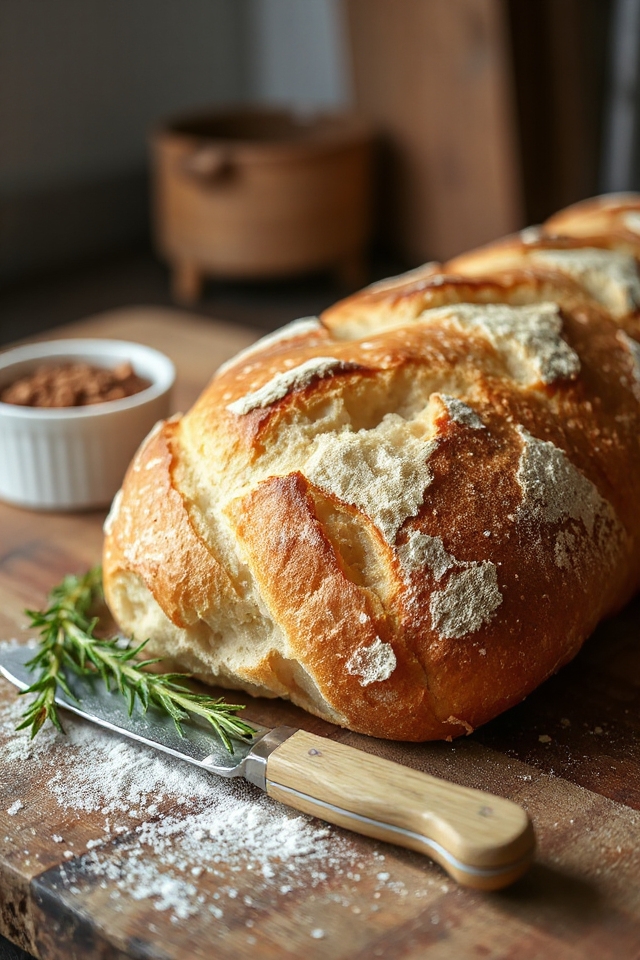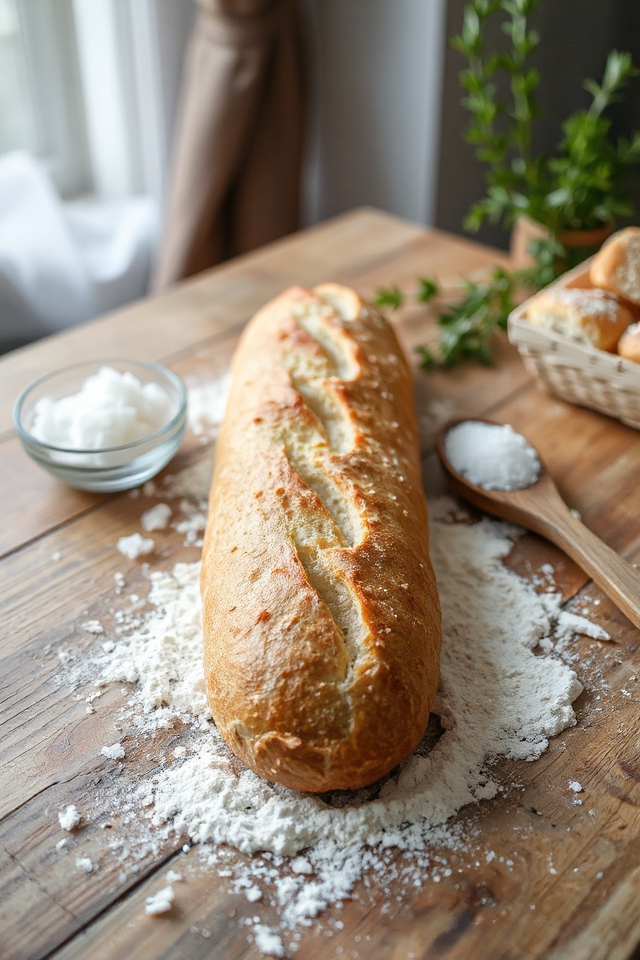Why You’ll Love This French Baguette Recipe
When you take a bite of a freshly baked French baguette, you’re not just tasting bread; you’re experiencing a culinary tradition that’s centuries old.
I love how the crust crackles under my teeth, giving way to a soft, airy interior. The aroma fills my kitchen, drawing everyone in.
This recipe is surprisingly simple yet yields impressive results, making it perfect for both beginners and seasoned bakers.
I appreciate the satisfaction of crafting something so classic and delicious. Plus, it’s versatile—great with cheese, as a sandwich, or simply enjoyed with butter.
You’ll fall in love with it, just like I have!
Ingredients of French Baguette
When it comes to making a classic French baguette, the ingredients are quite simple yet crucial to achieving that perfect loaf. Each component plays a crucial role in creating the texture and flavor we all adore. You won’t need any fancy ingredients or exotic spices—just some good old-fashioned staples that you probably already have in your pantry.
Let’s break down what you’ll need to get started on your baguette-making adventure.
Ingredients for French Baguette:
- 4 cups all-purpose flour
- 1 ½ cups warm water (about 110°F)
- 2 teaspoons sea salt
- 2 teaspoons active dry yeast
- 1 tablespoon sugar (optional, but helps with yeast activation)
Now, let’s chat a little about these ingredients. The flour is the backbone of your baguette, so using a good quality all-purpose flour can make a noticeable difference. If you’re feeling adventurous, you could even try bread flour for a chewier texture.
The yeast is what brings your dough to life, creating those lovely air pockets that make the inside of the baguette so light and fluffy. And don’t skimp on the salt—it’s not just for flavor; it helps control the fermentation process.
Water? Well, it’s the magic that brings everything together. Just remember to check that it’s warm but not too hot—nobody wants to bake their yeast, right?
How to Make French Baguette

Alright, let’s get down to the nitty-gritty of making your French baguette. First things first, you’ll want to grab a large mixing bowl and combine your 4 cups of all-purpose flour with the 2 teaspoons of sea salt. This is where the magic begins, as the salt won’t only add flavor but also keep the fermentation process in check.
Now, in a separate bowl, let’s activate our yeast. Mix 2 teaspoons of active dry yeast and 1 tablespoon of sugar (if you’re using it) into 1 ½ cups of warm water (around 110°F). Give it a gentle stir and let it sit for about 5 to 10 minutes until it’s frothy. It’s like a little yeast party, and you want to make sure they’re all dancing before you invite them into the flour party.
Once your yeast is ready to go, pour it into the flour and salt mixture. With a wooden spoon or your hands (who doesn’t love getting a little messy?), mix it all together until it forms a shaggy dough. Don’t worry if it looks a bit rough around the edges; that’s completely normal.
Now, transfer this dough onto a floured surface and knead it for about 10 minutes. You’re going to want to channel your inner strongman here. Knead it until it’s smooth and elastic, almost like you’re trying to impress a loaf of bread. If it sticks to your hands too much, sprinkle a little more flour, but be careful not to overdo it.
After your dough is all kneaded and ready, place it in a lightly oiled bowl, cover it with a damp cloth, and let it rise in a warm spot for about an hour or until it doubles in size. This is the perfect time to clean up your kitchen – or maybe just sneak a cookie.
Once it’s puffed up like a fluffy cloud, punch it down (yes, you get to do that) and turn it out onto a floured surface again. Divide the dough into two equal pieces and shape them into long, baguette-like forms. Place them on a baking sheet lined with parchment paper, cover them again, and let them rise for another 30 minutes.
Now for the fun part: preheat your oven to 475°F. Just before baking, make a few shallow slashes on the tops of your baguettes with a sharp knife. It’s like giving them their little window to vent. For extra crispiness, you can toss a cup of hot water into a pan on the bottom of the oven to create steam.
Slide those beauties into the oven and bake for about 20-25 minutes, or until they’re golden brown and sound hollow when you tap the bottom. The aroma will be irresistible, and you’ll feel like a true French baker.
Once they’re out, let them cool for a few minutes before slicing. And there you have it, your own homemade French baguette, ready to be devoured. Bon appétit!
French Baguette Substitutions & Variations
While traditional French baguettes are a delight on their own, experimenting with substitutions and variations can elevate your baking experience.
For a whole grain twist, I often swap a portion of all-purpose flour with whole wheat flour, adding a nutty flavor.
Want a gluten-free option? Try a gluten-free flour blend instead, though hydration might need adjusting.
Adding herbs like rosemary or garlic can bring a unique taste, too.
Sometimes, I even incorporate a touch of olive oil for a softer crumb.
Don’t shy away from using different shapes; batards or rolls can be just as satisfying as classic baguettes!
What to Serve with French Baguette
Although French baguettes are delicious on their own, they truly shine when paired with the right accompaniments.
I love serving them with creamy brie or tangy goat cheese, which complement the crusty exterior perfectly. For a heartier option, I often pair slices with savory pâté or smoked salmon.
Fresh herbs, like basil or rosemary, add a fragrant touch, while a drizzle of olive oil or balsamic glaze can elevate the experience.
You can’t go wrong with a classic tomato salad on the side, either.
These combinations can turn a simple baguette into a fantastic meal that’s sure to impress!
Additional Tips & Notes
To achieve the perfect French baguette, it’s essential to pay attention to a few key details.
First, make sure your ingredients are fresh; high-quality flour and yeast can make a big difference. I recommend using a baking stone for even heat distribution, which helps create that beautiful crust.
Don’t rush the fermentation process; let the dough rise until it’s doubled in size for the best flavor.
Finally, when scoring the dough, be confident and quick—this helps the baguette expand while baking.
Trust me, these little tips will elevate your baguette game to a whole new level!
